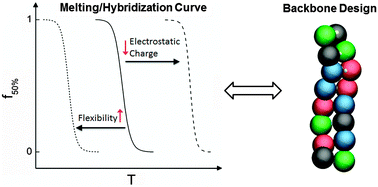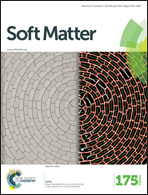Effect of backbone chemistry on hybridization thermodynamics of oligonucleic acids: a coarse-grained molecular dynamics simulation study†
Abstract
In this paper we study how varying oligonucleic acid backbone chemistry affects the hybridization/melting thermodynamics of oligonucleic acids. We first describe the coarse-grained (CG) model with tunable parameters that we developed to enable the study of both naturally occurring oligonucleic acids, such as DNA, and their chemically-modified analogues, such as peptide nucleic acids (PNAs) and locked nucleic acids (LNAs). The DNA melting curves obtained using such a CG model and molecular dynamics simulations in an implicit solvent and with explicit ions match with the melting curves obtained using the empirical nearest-neighbor models. We use these CG simulations to then elucidate the effect of backbone flexibility, charge, and nucleobase spacing along the backbone on the melting curves, potential energy and conformational entropy change upon hybridization and base-pair hydrogen bond residence time. We find that increasing backbone flexibility decreases duplex thermal stability and melting temperature mainly due to increased conformational entropy loss upon hybridization. Removing charges from the backbone enhances duplex thermal stability due to the elimination of electrostatic repulsion and as a result a larger energetic gain upon hybridization. Lastly, increasing nucleobase spacing decreases duplex thermal stability due to decreasing stacking interactions that are important for duplex stability.


 Please wait while we load your content...
Please wait while we load your content...